Ever wonder how to make your own mustard? It’s actually quite easy to do, with only a few simple steps. Here is how to make mustard at home.
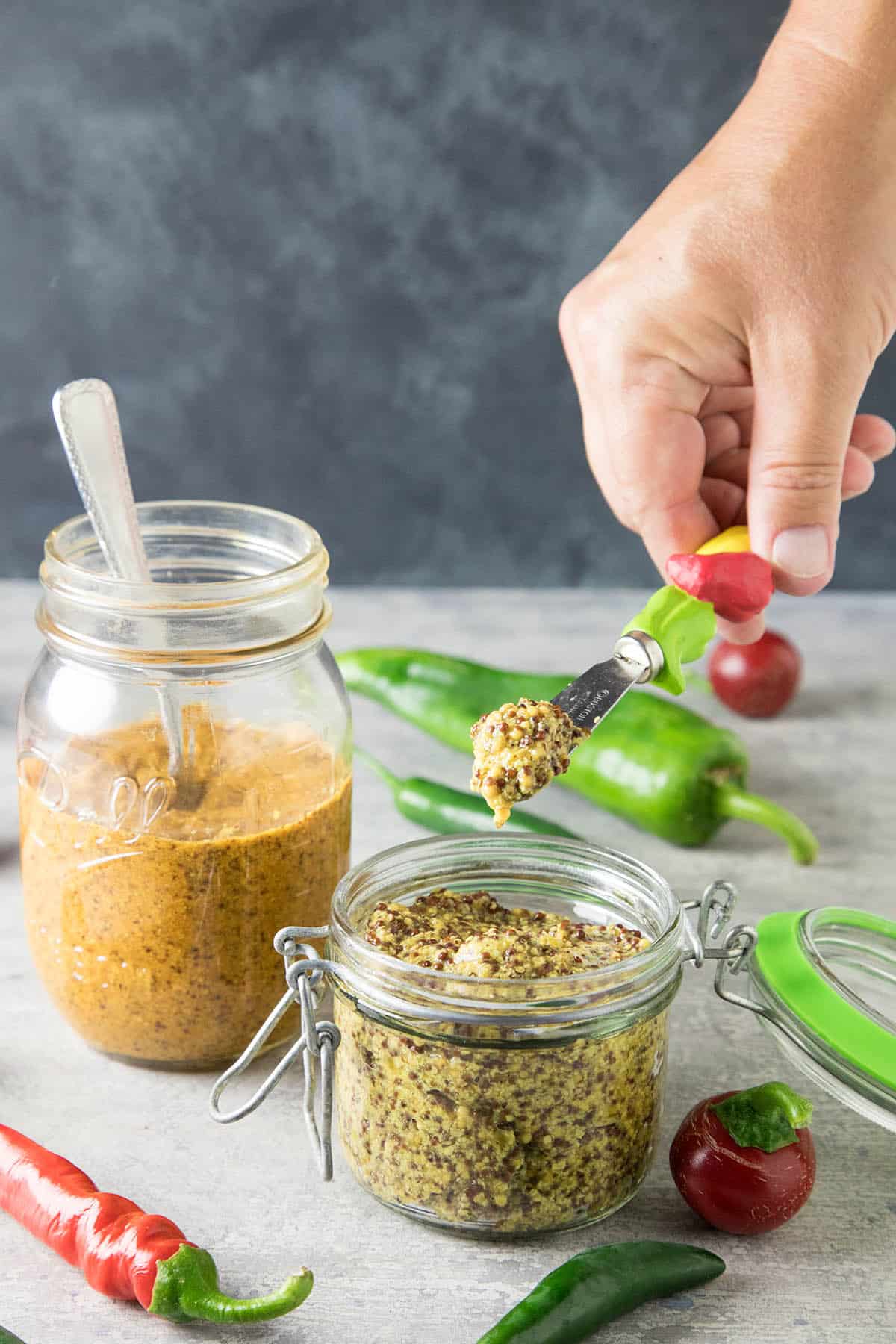
Homemade Mustard Recipe (How to Make Mustard)
Mustard is one of the world’s most beloved condiments. It is made from the pungent seeds of the mustard plant which are mixed with a liquid to form the basic paste that all mustard is made of.
The Origins of Mustard
Mustard has been around for millennia. The ancient Romans loved the stuff, and the name “mustard” originates from one of their original preparation methods of mixing unfermented grape juice, or “must”, with mustard seeds to create “burning must”, or “mustum ardens”.
“Must-ard” it is thus named, and here we are today, enjoying it in so many creative and flavorful ways.
There are discussions of how mustard was originally enjoyed and its typical uses, but I find those irrelevant to making mustard, as I personally enjoy mustard for a huge variety of uses, from using it as a simple spread for sandwiches or hot dogs to making rubs for the barbecue to using it as an ingredient in homemade sauces and so much more.
The point of this article is to break down the very simple process of making mustard so you can make it however you want, and use it however you want. Gone are the days of limiting yourself to what the stores offer you.
Armed with the ability to make your own mustard, you are now free to incorporate all sorts of your preferred ingredients to please your taste buds.
For me, this typically includes some type of chili pepper for obvious reasons, but I also enjoy sweeter elements mixed with pungent flavors and herbs. My wife, Patty, prefers her mustards on the pungent side and not quite as hot. She loves dijon mustard.
This is not a problem as I can easily make a base mustard, divide it in half, then season each half differently for our divided preferences.
So, are you ready to make some mustard?
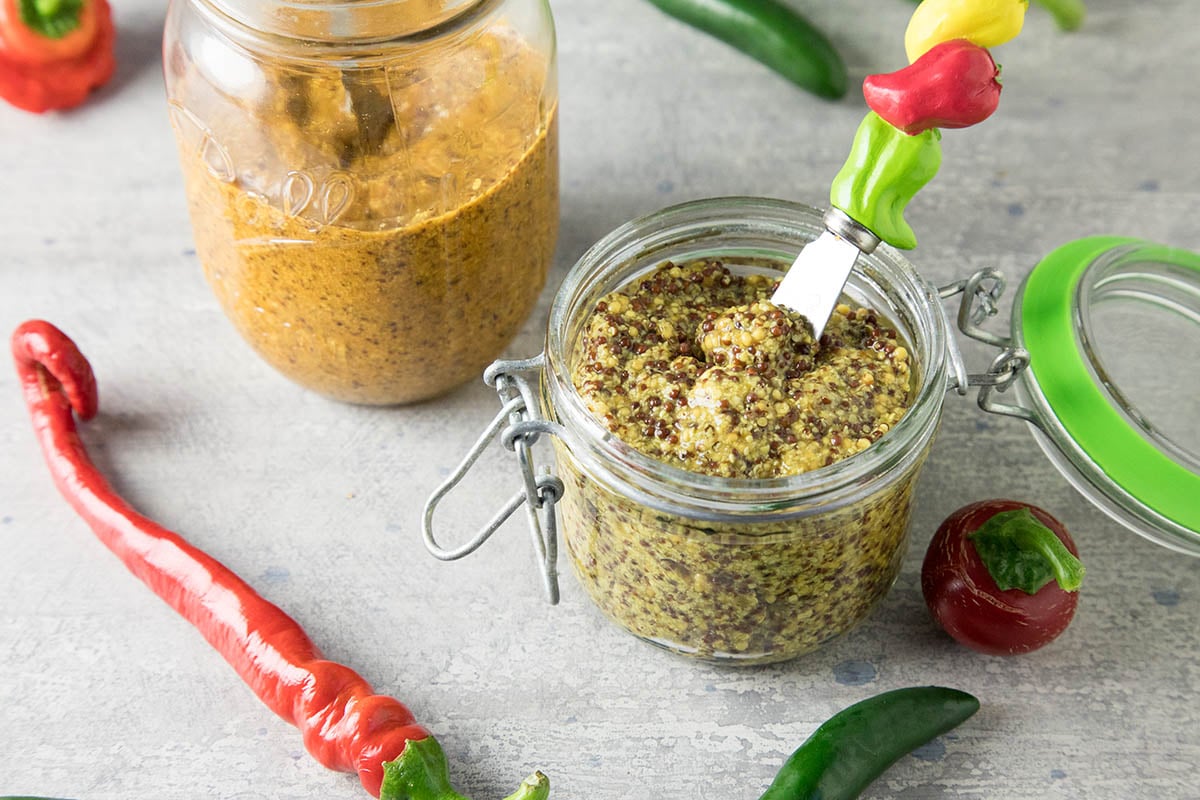
How to Make Mustard - the Basics
A very basic mustard includes mustard seeds and a liquid. The seeds are sometimes ground before liquid is added or the mixture is processed afterward. There are 3 types of mustard seeds:
- Yellow (or White) Mustard Seeds: These are the most widely available and most popular.
- Brown Mustard Seeds: These are more pungent that yellow mustard seeds and are quickly gaining popularity.
- Black Mustard Seeds: These are more popular in Indian, Asian and Middle Eastern cooking, though they are also gaining popularity in the U.S. They are also quite pungent and personally recommended.
A basic ratio for making a grainy mustard is to mix 1 part mustard seeds to 2 parts liquid. Let the mixture soak overnight to allow the seeds to absorb the liquid.
Another basic recipe for making smoother mustard is to grind mustard seeds into a flour, then mix it with a liquid until you achieve the consistency you prefer.
NOTE: When letting the mixture soak overnight, you can leave it out on your counter top or set it in your pantry. Do not refrigerate it, or the absorption process may not work. One reader did this and her mustard would not mix.
These are just the basics, and as you’ve probably already figured, there are certain variables which allow you to make a nearly infinite variety of mustards. They are:
Mustard Seeds
You can use any combination of mustard seeds to make mustard.
Mustard Seeds vs. Mustard Powder
Starting with mustard seeds will result in a grainier mustard. After the initial soaking, you can serve the mustard as is, with plump, heavy grains, or process it to your preference of smoothness. You will still have some whole seeds most likely, even with lots of processing.
Using mustard powder will result in a very smooth mustard, more akin to the yellow stuff you find in store bought squeeze bottles.
You can always grind mustard seeds with a mortar and pestle or a spice grinder to make powder.
Liquid
You can make mustard with water, though other options include wine, beer, fruit juice, cider, whiskey, vinegar (white wine vinegar, apple cider vinegar, malt, so many options), and many others.
Of course you can include a mixture of liquids as well with your own preferred ratios.
Liquid Temperature
The temperature of your added liquids makes a difference in the potency of the final mustard. Hot liquids disable the enzymes that produce the overall pungency, so if you prefer a milder mustard, use hot or warm liquids.
If you prefer a strong, pungent mustard, use cold liquid. Room temperature liquid is commonly used.
Extra Ingredients
Here is where you can get REALLY creative. Add in a diversity of flavors, such as roasted chili peppers, roasted vegetables (onion or garlic are great), honey or sugar, brown sugar, salt, seasoning blends, fresh herbs, nuts, berries, fruits, smoked peppers, you name it.
If you love the taste of it, consider adding it to a mustard.
The addition of salt and vinegar will help keep your mustard longer if you’re using many ingredients. I almost always use vinegar and a bit of salt, though for me, it’s mostly about the flavor with those ingredients.
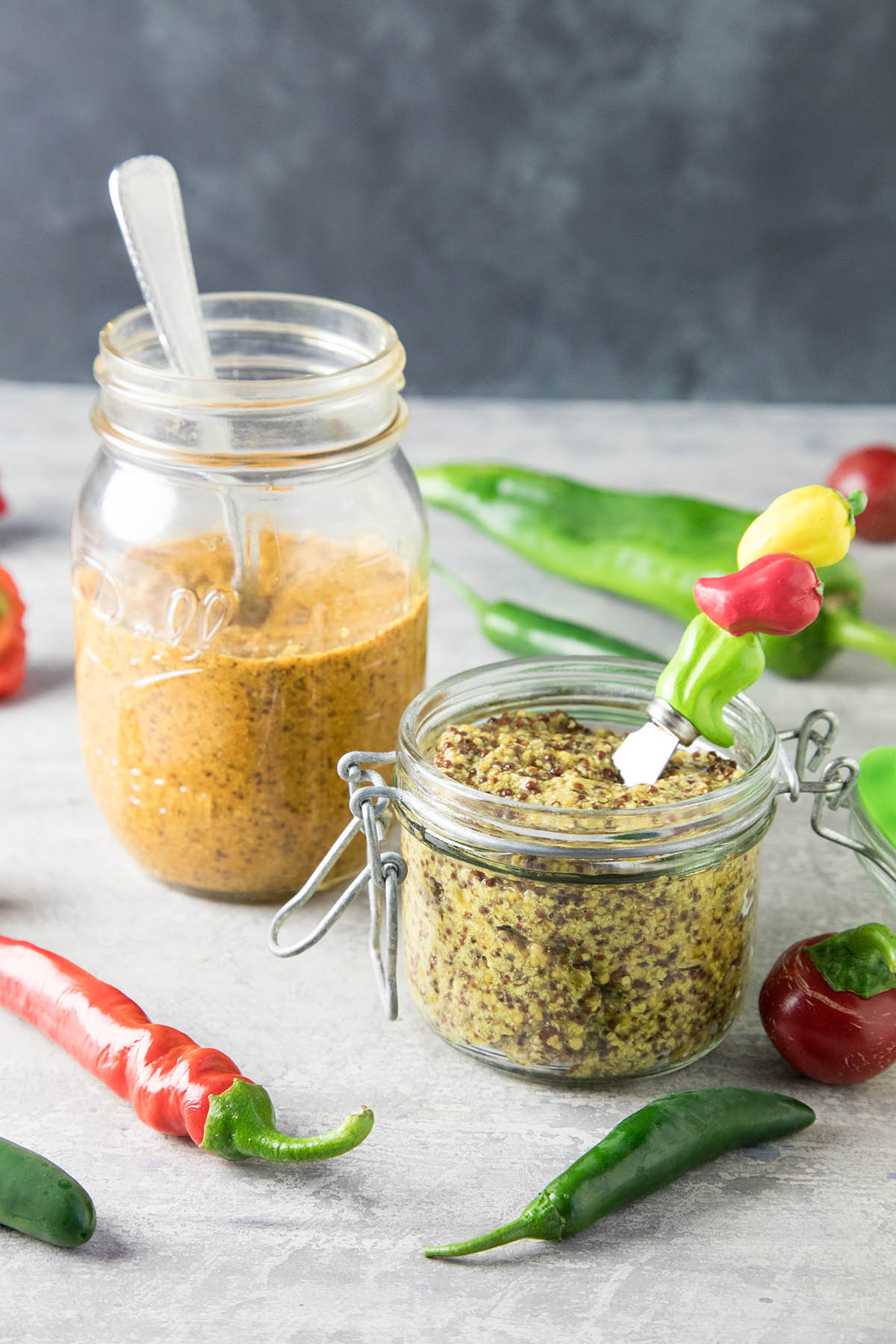
A Simple Mustard-Making Formula – Step by Step
Here is a breakdown of how to make a whole grain mustard at home.
Ingredients
- 1 cup mustard seeds (yellow, brown, and/or black)
- 2 cups liquid of choice
- Extra ingredients/flavorings – amounts are variable
How to Make Mustard at Home
- Add the mustard seeds and liquid to a large glass jar. Give it a solid shake and seal it up.
- Set into a dark place like the cupboard for a day (24 hours) or 2 to allow the seeds to absorb the liquid.
- Process the mixture in a food processor with your extra ingredients to your desired consistency. Adjust with a bit of salt, if desired. You can add in a bit of water if you feel the mustard is too thick.
- Return the finished mustard to the jar and seal.
The flavors will be quite pungent at first, though they will mellow out over time as the mustard ages.
Storing Mustard
I personally like to keep the mustard in the fridge for safe keeping in a sealed glass jar. Properly prepared mustard is impervious to harmful bacteria, but flavors can become bitter and it can dry out, so for me, the refrigerator it is.
If you prefer to not refrigerate your mustard, keep it in a cool, dark place, like the cupboard.
Help! My Mustard is Bitter
Some mustard seeds have an inherent bitterness. You can add a bit of honey or other sweet element to counteract any bitterness that you taste. It is likely from the powder or seeds you started with, which CAN have some bitterness.
One way to help reduce bitterness is to soak the mustard seeds before you start in a bit of water and let sit overnight, or at least rinse them very thoroughly to remove bitter elements.
How Long Does Mustard Last? Storage Information
Prepared mustard can last for years if properly made, though you will experience loss of flavor and pungency. Using an acid, like vinegar, will keep the mustard for longer. Just be sure to keep it properly sealed.
Refrigeration is a best practice.
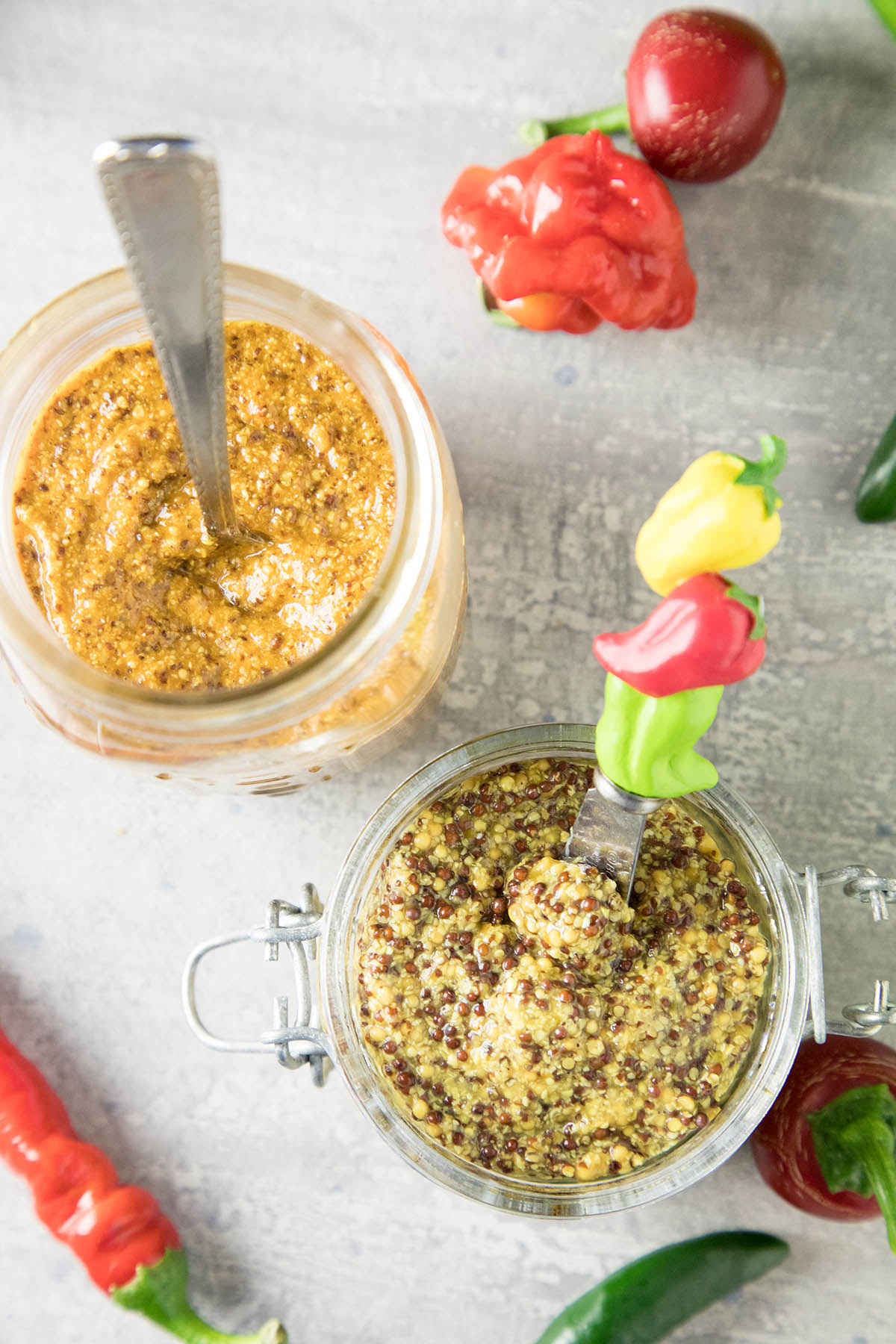
Mustard Recipes
Here are some links to the different mustards I enjoy making.
See the list of mustard recipes in our Homemade Condiments Recipes. If you enjoy mustard, perhaps you'll also enjoy my homemade ketchup recipe.
Here are some links to purchase mustard seeds from Amazon. These are affiliate links, my friends. I buy them in bulk for making mustard whenever I want. Great stuff!
- Yellow Mustard Seeds
- Brown Mustard Seeds
- Black Mustard Seeds
- Mustard Powder
Let me know how your mustard turns out! Send pics! Enjoy!
Got any questions? Ask away! I’m happy to help. If you enjoy this recipe, I hope you’ll leave a comment with some STARS. Also, please share it on social media. Don’t forget to tag us at #ChiliPepperMadness. I’ll be sure to share! Thanks! — Mike H.
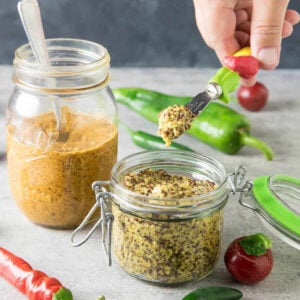
How to Make Mustard (Homemade Mustard Recipe)
Ingredients
- 1 cup mustard seeds yellow, brown, and/or black
- 2 cups liquid of choice Try a mixture of beer or water and vinegar
- Extra ingredients/flavorings – amounts are variable
Instructions
- Add the mustard seeds and liquid to a large glass jar. Give it a solid shake and seal it up.
- Set into a dark place like the cupboard for a day or 2 to allow the seeds to absorb the liquid.
- Process the mixture in a food processor with your extra ingredients. Adjust with a bit of salt, if desired. You can add in a bit of water if you feel the mustardis too thick.
- Return the finished mustard to the jar and seal.
Notes
Nutrition Information



Carrie L Johnston says
How do you choose between making a cooked mustard from powder or an uncooked mustard from whole mustard seeds? I've read your articles on both types of mustard. They seem to have the same variables. So, why choose one over the other?
Mike H. says
Hey, Carrie. It really comes down to the flavor and texture you’re after. If you want something smoother and less intense, go for cooked mustard from powder — it’s milder and works well in sauces. But if you’re craving something bolder and a bit grainy, uncooked mustard from whole seeds packs more punch and adds texture. Both are great, just depends on how you want to use it!
Nick says
Made loads of mustard following this recipe, usually add 7/8 dried reapers or scorpions to seeds while soaking, amazing!
Mike H. says
Awesomeness. Thanks for the feedback, Nick!
Sonia says
I have struggled with making pickled mustard seeds and thought I would see how similar your mustard recipe is and if you have tips for the main problem I have encountered - bitterness that is not eased by the suggestions of soaking, rinsing, and adding sugar. Seems as though the recipe you have listed for mustard here gives the same suggestions for reducing bitterness. Any other suggestions? I used black mustard seeds one time and then yellow mustard seeds another.
Mike Hultquist says
Sonia, mustard seeds contain glucoside, which produce bitter flavors when mixed with water. Bitterness is an inherent flavor of mustard, though it typically fades after a couple days. How long did you wait before tasting? Let it rest in the fridge at least a week then try it again, see if it has mellowed. Also, you can cook it. Simmer your batch for 10 minutes with a bit of water (so it doesn't burn), then mellow a week in the fridge, see if this helps.
Leif says
The mustard recipe video I've always been intrigued by is from "ChefSteps" where they boil and decant the seed like, five+ times before finally processing it. I've not experimented with anything beyond using Coleman's powder, [yet] but comments I've seen here about bitterness may be the reason for this extreme method, so I pass it on. Some seeds seem to have a very off-flavored covering that must be washed away vigorously.
As to the Coleman's-based mustard: IF you like spicy, Ah-HOO-Ahh! try that as a base and go from there IMHO. Just don't exhale through your nose after giving it a taste! yeow. I personally want to try adding some of the peppers I smoked then dried following another great recipe here.
So many great flavors to try, so little time.
Mike H. says
That is absolutely true. But take it one recipe at a time and you won't notice how you've tried them all!
Wes says
easy receipt, just loved it. and the mustard is taste.
yes it should sit in the fridge for a couple of days but it only gets better. thanks
Mike Hultquist says
Thanks, Wes!
Jack McCurdy says
Hi Mike,
Love your recipes. Here is my variation on your mustard one.
HOT MEX MUSTARD
Ingredients
1 cup mustard seeds yellow, brown, and/or black
1 ½ cups Negro Modelo
½ cup vinegar
2-3 Chiles de Árbol, stemmed seeded and crushed to small flakes
Instructions
Crush the stemmed seeded chiles in a molcajete.
Rinse the mustard seeds then put them in a jar and cover them with water. Let them sit overnight, then drain.
Add the mustard seeds, liquid and chiles to a large glass jar. Give it a solid shake and seal it up.
Set into a dark place like the cupboard for a day or 2 to allow the seeds to absorb the liquid.
Process the mixture in a food processor with your extra ingredients. Adjust with a bit of salt, if desired. You can add in a bit of water if you feel the mustard is too thick.
Return the finished mustard to the jar and seal.
Mike Hultquist says
Sounds perfect, Jack! I love it.
Li says
Hi Mike! I have been enjoying several of your recipes lately, especially learning to make mustards. I love what I've made so far. My confusion comes with black vs brown mustard seeds. Your links for both go to the same Frontier product "they" call brown. I have ordered several different black and brown mustard seeds from various companies. They all look the same to me as far as color. Is there a visual difference in them, or is it just a taste difference?
Mike Hultquist says
Li, I updated the link. There are visual differences in color. The black mustard seeds are distinctively black.
Li says
Thanks Mike! LOL, I guess I have a LOT of black seeds to use!
Miska Knezevic says
Thank you for this recipes!
Charles Pascual says
Mike, what do you add to make your Dijon mustard?
Mike Hultquist says
Charles, Dijon mustard is made with wine as the liquid, or a mixture of wine and vinegar.
D.B. says
Dijon Mustard was originally made using verjuice as the liquid, which is a non-alcoholic liquid made from the juice of underripe fruit, typically grapes. Its flavour profile is somewhere between wine and vinegar, which is why so many mustards nowadays use either wine, vinegar or a combination of the two.
Ole says
An expert in Dijon is required to watch you make it, before it can be called Dijon, no kidding 😛
Larry says
I didn't see a recipe for Dijon mustard although you mentioned your wife likes it. While I wait for an answer, I'm off to Penzy's to see what they have in the way of mustard seeds.
Mike Hultquist says
Larry, I don't have a recipe specific to Dijon, but it is usually made with wine as the liquid, or a mixture of wine and vinegar.
Ole says
Technically it is only allowed to be called Dijon, when a Dijon expert have been watching while it's made... So just call it Mustard 😉 Stupid rules, right!?
Lou says
The mustard powder linked to in the post is out of stock at Amazon. Are there others that you recommend?
Michael Hultquist - Chili Pepper Madness says
Lou, look for any Coleman's brand mustard seeds or powder. Others will work as well. Let me know how it goes for you.
Robert says
We've been making our mustard the same way for years. My wife loves this version, I kick up mine a bit with a ferment.
Another winner Mike, thanks again.
Michael Hultquist - Chili Pepper Madness says
Thanks so much, Robert. I appreciate it.